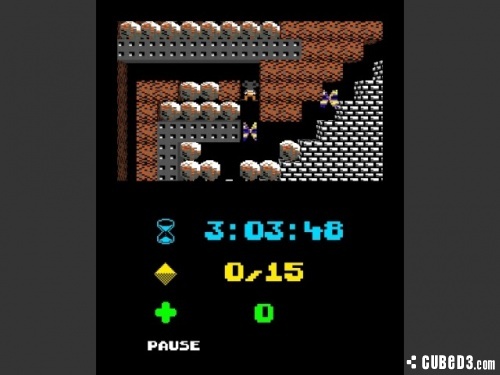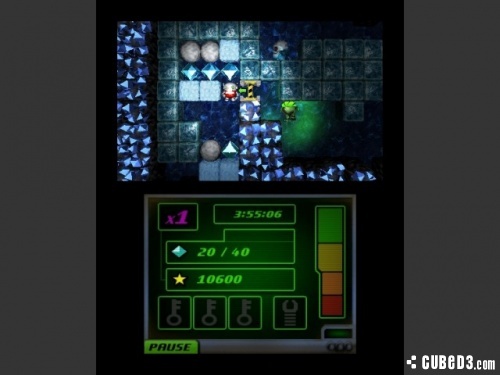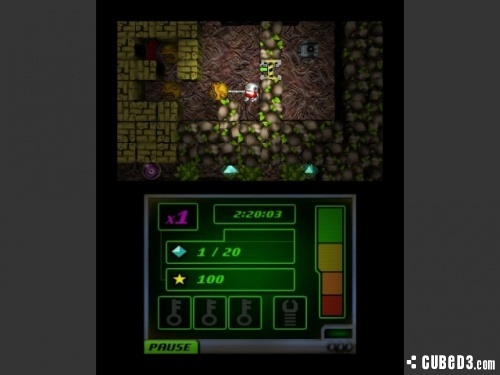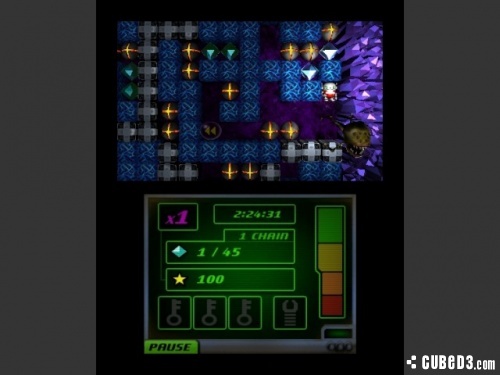Boulder Dash XL 3D (Nintendo 3DS) Review
By Rudy Lavaux  01.10.2012
01.10.2012

For those who have probably never heard of it, Boulder Dash was a much beloved game during the mid 1980s. The brainchild of Peter Liepa and Chris Gray, it was ported to and popular on most of the micro-computers that were relevant at the time, namely the Commodore 64, Amstrad CPC 464 and the Atari 800 on which it originated in 1984. The C64 version is probably the biggest selling one and most popular version of all, due to the popularity and commercial success of the platform at the time, and also perhaps thanks to having the best scrolling, colours, and sound effects (the first game is available on Wii Virtual Console). Many subsequent versions were made, all under the supervision of First Star Software, owner of the Boulder Dash franchise, but handled by different people beyond the first two. These different episodes brought their share of new ideas that made the franchise move forward, but also sometimes stray far from the original concept. The Nintendo DS got its own version of it in 2007, in the form of Boulder Dash: Rocks!. In 2011, Boulder Dash XL came out on Xbox Live Arcade and PC. The Nintendo 3DS game, Boulder Dash XL 3D, is a direct-to-retail port of the same game.
The concept in Boulder Dash is fairly simple. Rockford, once a little humanoid character but inexplicably turned into a robot for this release, or Crystal, his female counterpart, are controlled. The goal is to explore every cave in the game, each one requiring the character to collect a certain number of diamonds for the exit to the next cave to be opened, all the while avoiding various hazards. Each cave is filled with various kinds of elements. The most prominent is dirt, which can be dug through, as well as diamonds, and plenty rocks that can be pushed (but not pulled). Walls are also found, which can't be passed unless making something explode right next to them, and titanium walls, of which the boundaries of each level are made of, which are totally indestructible. In some levels, there's also an amoeba, a giant green gooey monster that acts like The Blob from the classic horror movie, in that it eats anything in its path, taking up more and more space as it grows larger and larger. Its fate is either to transform into a giant heap of diamonds if trapped with rocks and diamonds before it reaches critical mass, or if it exceeds it, to morph into boulders that are useless.
It's fairly easy to be destroyed by the various hazards in each level. Death can come at the hands of enemies that roam around, being crushed by a falling boulder, or simply ending up trapped by boulders while trying to collect some hard to reach diamond, forcing a level restart. It's hard to tell what the perspective used in this game is. It seems to be a 2D scrolling plan (here made of polygons) viewed from the side, judging from the way it moves and how the gravity seems to attract boulders and diamonds towards the bottom part of the screen, however the lead character and most enemies are allowed to move in four directions, regardless of gravity. This has been true since 1984 in this series, though, so arguing over it now is fruitless.

Setting aside those considerations for realism, the core of this simple concept lies within how it handles physics. Paying a lot of attention to how the different elements are positioned is imperative. For example, a diamond or boulder standing on the edge of a destructible wall, or on top of another diamond or boulder, will roll off it if nothing else prevents it from doing so...but not if it stands on a square piece of dirt, a titanium wall, or even Rockford's head. There are such rules that must be taken into consideration while exploring each cave to avoid being crushed by falling debris, or trapped by rolling rocks.
More new elements were added to the original formula in Boulder Dash XL. Now, there exist doors that can only be opened by keys found along the way, barring the passage to more diamonds, or the exit itself. Both robots can also now pick up an item that gives them the ability to use (only once) their extendable arms to pull forward distant rocks, diamonds and enemies, or push them back by as far as the empty space available allows in the chosen direction, opening new possibilities for use and puzzles involving that ability. Furthermore, some classic elements such as the magic walls, which could transform all boulders that pass through them into diamonds, and vice versa, are now machines that achieve the same thing.
Boulder Dash XL 3D offers several modes of play with their own sets of caves. Typically, there is access to a first set of five caves when starting, and as soon as at least three of each group of five are beaten, the next set is unlocked. The main mode, and most meaty one, is Arcade, which offers 100 caves to beat. It's not very challenging, until reaching the last 20 or so, however. Save for some very few exceptions, all caves can be beaten without gathering all the available diamonds. Saying that, though, the most skilled of players will want to get a "perfect" bonus on each level by grabbing each and every one of them.

The Zen mode is exactly the same as Arcade, except there is no score, no time limit, and all caves are already unlocked to begin with; thus it is a good way to practice each cave. Another option available is Puzzle. This holds 25 smaller caves where the focus is to manage to collect all diamonds and reach the exit while working within a very confined space where players must take advantage of every possible trick allowed by the physics engine to avoid trapping a precious diamond, the lead character, or block the way to the exit -- this a bit more challenging!
The Score mode holds only four caves, in which one single diamond opens the exit, but the goal is to try to get the biggest score possible within a very strict time limit. There is barely enough time to collect every single diamond and this comes across as the biggest challenge the game has to offer. It's a shame that there's absolutely no way to compare personal scores with anyone else, since there's no online leader board function.
Finally, on the same level of difficulty as "Puzzle," there's Retro. This one attempts to recreate the experience of the first games by imitating the graphics of the Commodore 64, using the same enemies and elements that the caves were composed of, but using 3D graphics like the main game...However, the stereoscopic effect cannot be initialised in this mode. Inexplicably, the sound effects are not those from the Commodore 64 version, though, nor are any of the micro-computer ports for that matter, but they sound like they have been taken from the NES version. This mode sticks to the original rules, so falling diamonds are deadly here, any hit from an enemy is deadly (there is no life bar), and a defeated enemy dies in a big explosion that destroys the elements in all squares directly next to it.
The game labels this set of caves as "extra difficult," yet they are nowhere near as hard as the caves from the classic games. Part of the reason is that the design feels much less clever this time around, and another part is that the 3D engine used runs much slower than the old 2D one found on 8-bit computers.

In the past, Rockford would have never been able to outrun any enemy or falling rocks. Once a rock sat on an empty space, it would fall right away and not just hang in midair for a split second, thus leaving enough time to get out of its way. Finally, expanding walls would expand at almost eight times the present speed. The list of differences goes on, but the bottom line is that the Retro mode is likely to appeal to old fans just from looking at it, but will induce a bad sense of disappointment in them once they try it and find out that it doesn't quite feel like the real thing, though it comes close if the lower speed isn't counted. Boulder Dash XL 3D still has a nice set of caves, admittedly, and newcomers won't notice the difference. They might even find that these caves are indeed a tad more challenging than the regular ones. However, if that was the intended purpose of this mode (and not trying to attract old-school fans, as is clearly the case), then the development team might as well have gotten rid of the old-school graphics altogether.
On the whole, Boulder Dash XL 3D is a port that offers everything that was on the Xbox Live and PC versions, only with the addition of a stereoscopic 3D mode that brings nothing since all the action takes place on a same scrolling plane and there's little "depth" to be felt whatsoever. By sticking to the original package, minus the achievements found on Xbox Live, what's left is a decent package that offers some excellent fun, but will feel far too short for the most skilled players, and especially long-time Boulder Dash fans. What feels like an even bigger waste of potential is the lack of a level editor and online sharing system. The touch screen of the 3DS simply begs to be used for letting players create their own headaches. Boulder Dash Construction Kit already existed in 1986 for micro computers, but has yet to be revisited in our modern era. The 3DS was the perfect occasion to do so, but that was not to be, and that's a pity.

Cubed3 Rating
Very Good - Bronze Award

Boulder Dash XL 3D, just like its PC and Xbox Live Arcade counterparts, takes a very old school and hardcore gamer oriented franchise and turns it into a more casual style package. It still manages to provide a lot of fun, but perhaps not as much as it would have done had it stuck more closely to what truly made the appeal of the original franchise: challenge, speed and fiendishly clever level-design that made the most of the physics engine. The latter could have been simply solved by letting players create their own caves and share them, but that is not the case here. At a lower price-point than most retail 3DS titles, it's still worthy of interest for any puzzle game fan, since the basic concept remains very well reproduced, but it just fails to fully realise its immense potential by trying to appeal to the wider audience. The new gameplay ideas sort of make up for that, though. If looking for a retail brain teasing action puzzle game on 3DS, one that is not too challenging, Boulder Dash XL 3D is just what may well be needed at its lower price.
Comments
Comments are currently disabled

 Sign In
Sign In Game Details
Game Details
 Out now
Out now  Out now
Out now  None
None  Out now Also on
Out now Also on 
 Subscribe to this topic
Subscribe to this topic Features
Features





 Top
Top

